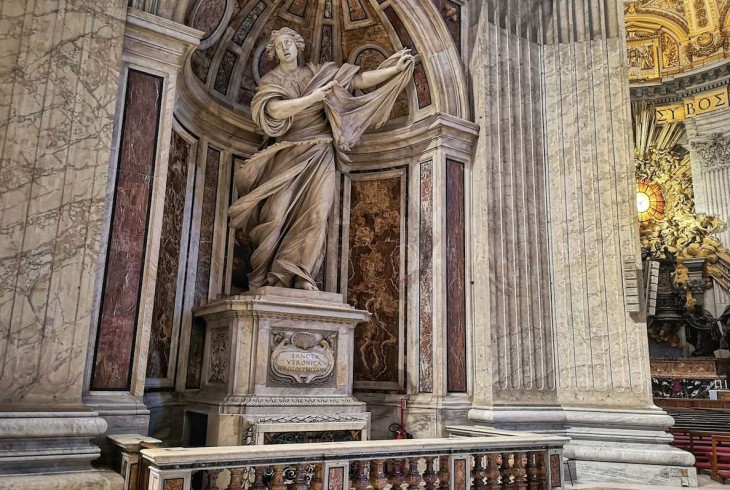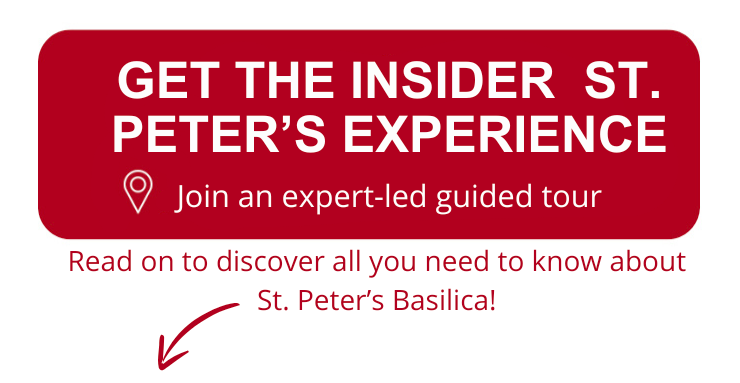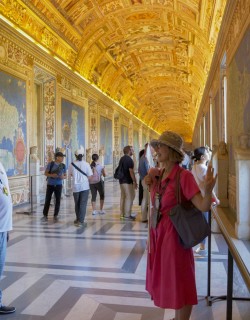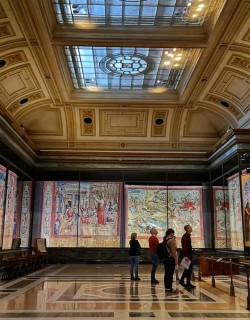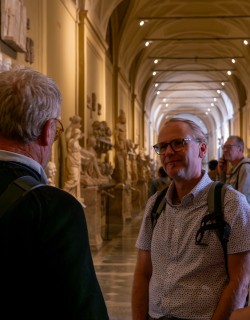Updated 14 March 2024
Saint Peter’s Basilica is a must-see for everyone coming to Rome: whether it’s your first time in the Eternal City or you’re making your umpteenth trip back, you always owe a visit to Rome’s most important church. With a history extending all the way back to the 4th century, Saint Peter's has been a top stop for visitors and pilgrims for nearly 2,000 years. But the world's largest church is about much more than religion: Saint Peter's is also a wonderful showcase of Renaissance and Baroque art.
From iconic favorites like Michelangelo's Pietà to delicately carved tombs and hidden mosaics, the basilica is a treasure trove of delights always capable of surprising even the most experienced of visitors. As an art historian living in Rome, I've been to St. Peter's more times than I can count - but I'm always discovering something new! You just can never get enough of this special place.
But what are the things you absolutely cannot miss when visiting Saint Peter’s Basilica? Read on to for our guide to 7 unmissable monuments that you have to see!
Saint Peter’s Grave
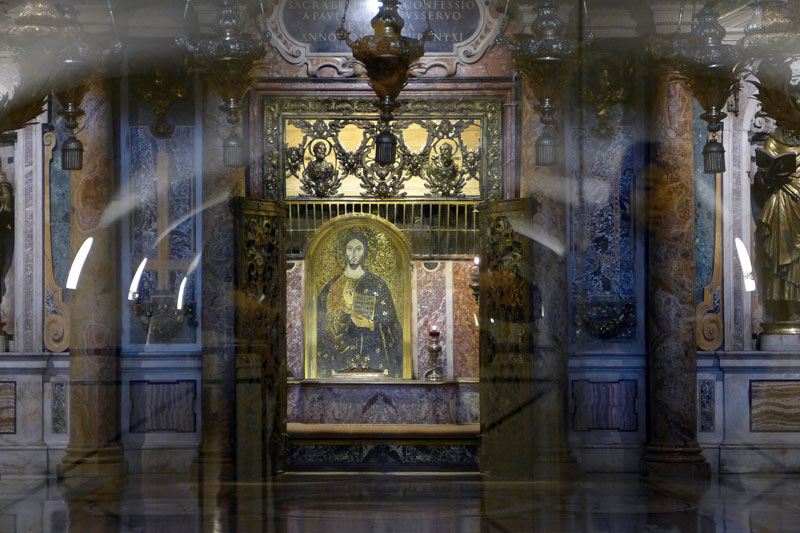
“And I tell you that you are Peter, and upon this rock I will build My church”. If you are familiar with the Gospel of Matthew, you’ll probably recognize this famous passage in which Jesus gives his apostle Simon, a humble fisherman from Capernaum, the new name of Peter - which literally means “rock”.
How is this related to Saint Peter’s Basilica? Saint Peter’s Basilica was literally built on top Saint Peter’s grave, which can indeed be considered the “rock” or the cornerstone of the building.
Saint Peter was martyred during the reign of the emperor Nero, around the year 67 or 68 AD, during the first persecution of the Christians. He was crucified upside down in the Circus of Nero, which was located in the exact same area where the Basilica and beautiful Saint Peter’s Square stand today.
After his terrible death, Peter was buried in a nearby cemetery. Saint Peter’s grave was originally extremely humble, and it was only in the 2nd century AD that Christians finally had the chance to build a little shrine over it to make it recognizable. Almost 300 years after Peter’s death, the emperor Constantine, after legalizing the Christian religion, had a proper church built on top of the apostle’s grave.
This ancient Basilica was gradually demolished in 1506, when Pope Julius II ordered the construction of a newer and bigger church fit to honor the Apostle: this is the magnificent church we can still admire today. Finding the exact location of Saint Peter’s grave is simple: from the outside, the position of the grave is marked by the shiny golden cross on top of the dome. Inside the church meanwhile, it’s marked by the beautiful bronze canopy above the main altar. The altar itself sits right on top of a little chapel, underneath which lies the humble grave that is traditionally - although not unanimously - identified with Saint Peter’s burial.
Michelangelo’s Pietà
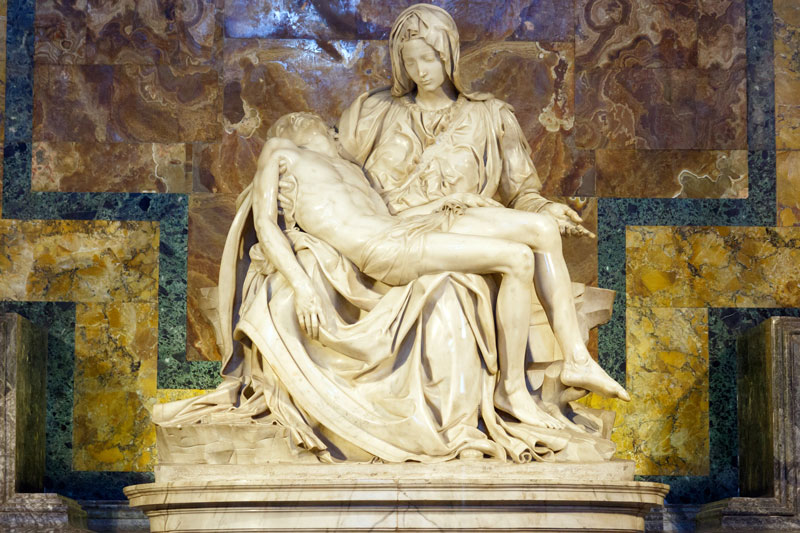
Located in the first chapel to the right of the entrance, the Pietà is Michelangelo’s most touching work, representing the Virgin Mary gently holding the body of dead Jesus in her lap with great composure and tenderness. The work was commissioned by Cardinal Jean Biléres de Lagraulas in 1498, for his tomb.
In only two years, the 23-year-old Michelangelo was able to create a work that remains even today an unparalleled masterpiece.
The sculptor interpreted this well-known subject in his very personal and original manner: in fact, going against the traditional iconography where the Virgin Mary was portrayed as a mature woman, Michelangelo emphasized her youth and innocence at the point that she looks even younger than her Son. The Virgin Mary bears a sash across her chest, with the signature of the artist.
As tradition has it, Michelangelo, who was not yet so famous at that time, added it after the inauguration of the statue: apparently, he had overheard some visitors wrongly attributing the Pietà to another artist. After this statue, he became so famous that he didn’t need to sign any of his other works. For more on this extraordinary artwork, check out our in-depth guide to Michelangelo's Pietà.
Bernini’s Longinus and the Crossing Sculptures
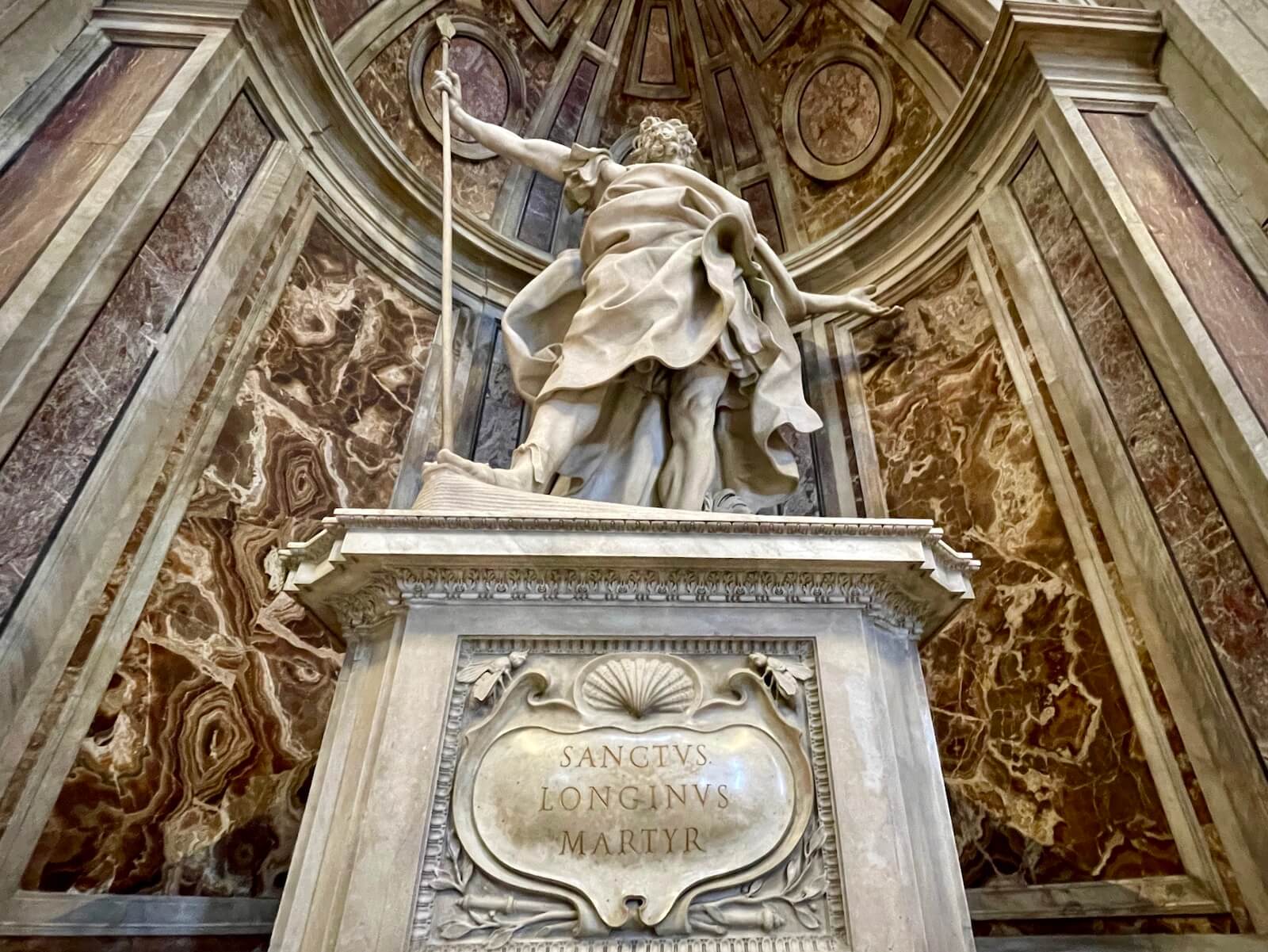
If Michelangelo’s Pietà represents one of the highpoints of Renaissance sculpture, St. Peter’s basilica is also home to some of the most indelible monuments of the Baroque age. In the century following the old master’s death and the consecration of the new basilica, the interior of St. Peter’s came to be associated with one great artistic personality more than any other: Gianlorenzo Bernini.
His massive statue of St. Longinus (over 4 metres high) in one of the niches at the crossing of the church is truly awe-inspiring. The spear-clutching Roman centurion marks the presence of one of Christendom’s most precious relics – the lance with which Longinus pierced Christ’s side during the Crucifixion, bringing about his own immediate conversion.
Three more massive statues stand silent guard over the crossing, each marking the site of further priceless relics: Andrew, Helen and Francesco Mochi’s Veronica, who flamboyantly displays the Veronica veil – reputed to preserve the face of Christ himself in its folds.
Bernini’s Canopy
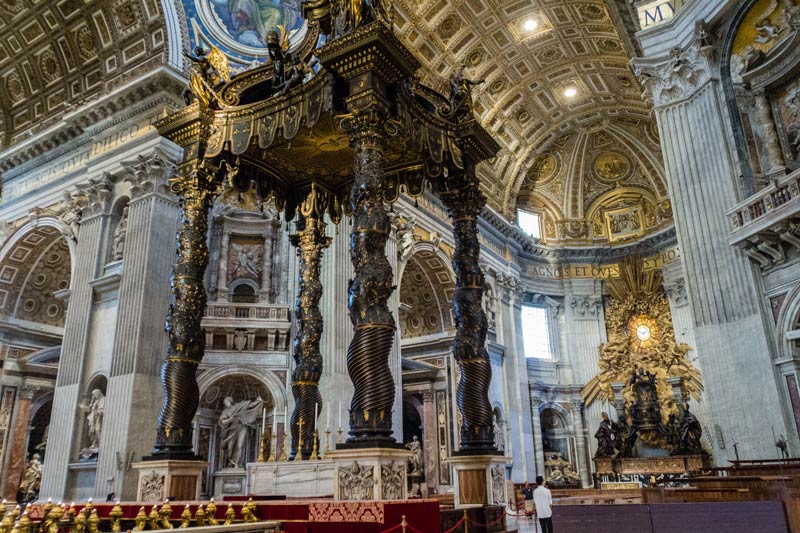
When entering Saint Peter’s Basilica for the first time, you can’t help but be overwhelmed by the unexpected grandiosity of the building. But once you adjust to the vastness of this immense church, the first thing that catches your eye is a huge bronze canopy at the end of the nave. Designed by Gianlorenzo Bernini, who is widely considered the master of the Italian Baroque, the canopy is meant to highlight the main altar, reserved only for the Pope himself.
It was the famous Urban VIII from the Barberini family, whose coat of arms is carved at the base of each of the four columns of the structure, who hired Bernini for this ambitious project in 1624.
With its beautiful spiraling columns decorated with vine leaves, the canopy has a very peculiar design meant to suggest the idea of movement and lightness, remarkable considering the size of the monument: in fact, it is more than 28 meters high. Beautiful statues of angels and little putti gently watch you from the top of the canopy, which is surmounted by a golden sphere with a cross. Above, Michelangelo's soaring dome provides an incredible backdrop. It's worth climbing the dome of St. Peter's for a fascinating view down onto the top of Bernini's canopy.
But where did all this bronze come from? Pope Urban VIII had pretty unorthodox ways of acquiring the materials he needed for his monuments: for the construction of the canopy, he took the bronze from more ancient buildings in Venice, Livorno and, according to tradition, even from the roof of the Pantheon in Rome. This tradition, although not confirmed by the most recent studies, gave rise to a famous Roman witticism: "Quod non fecerunt barbari, fecerunt Barberini" – what the barbarians didn’t do, the Barberini did.
John Paul II’s grave
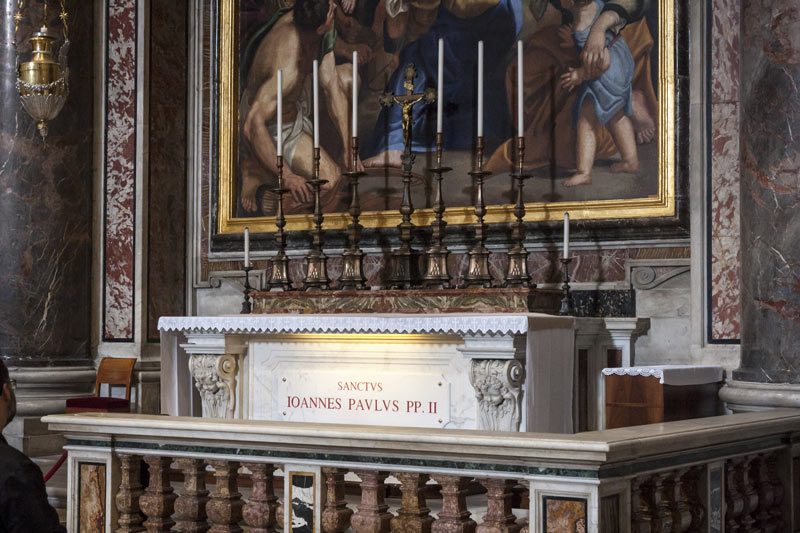
If you keep walking along the right aisle, a few steps past the Pietà, you will find the Chapel of Saint Sebastian. On most days you will find many people here on their knees, silently praying in front of the altar. If you manage to get closer, you will be able to read this inscription on the white marble altar, in red capital letters: SANCTVS IOANNES PAVLVS PP. II, Saint John Paul II.
With his 27-year-long pontificate, the Polish pope was one of the most popular pontiffs ever: during his funeral on April 8th 2005 in Saint Peter’s square, the large crowd attending suddenly started to chant loudly “Santo subito!” which literally means “Make him a saint now!”. And in fact, just 9 years after his death Pope Francis proclaimed him a saint in Saint Peter’s Square on April 27th 2014, in front of the more than 500,000 people that had gathered for the occasion.
The pope’s triple coffin (one made out of cypress, one of zinc and the last of chestnut, shut with golden nails) was originally buried in the Vatican Grottoes. It was moved to the Chapel of Saint Sebastian in 2011, when the Pope was declared “blessed”: in 2014, upon his canonization, the pope was finally honored with the title of “saint” - as you can read on the beautiful marble altar that is his final resting place.
The monument to Pope Alexander VII
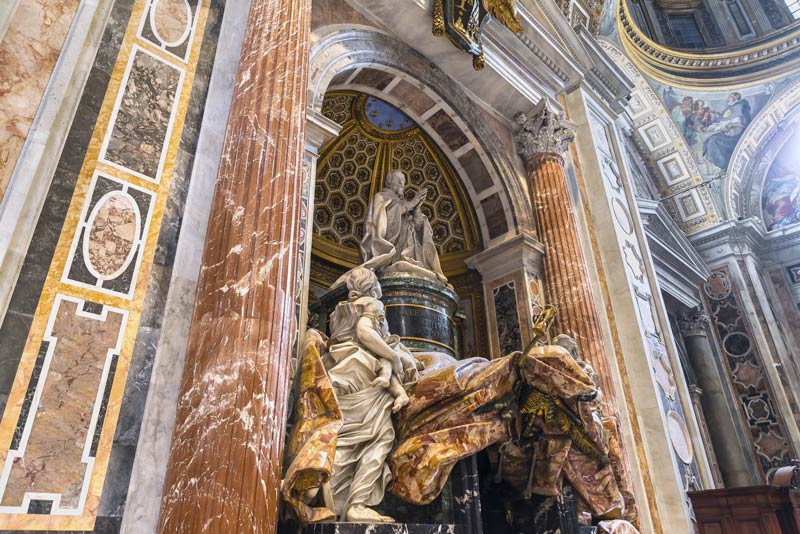
To the left of the Canopy, just a few steps away, you will find a very unusual monument: the memorial to Alexander VII. Designed by the 80-year-old Bernini, this monument is considered his very last great work, despite the fact that it was mostly executed by other sculptors supervised by the old master.
Although Pope Alexander VII had commissioned his funeral monument in the very first years of his pontificate, he never got to see it, dying before it was even started. The monument was in fact inaugurated in 1678, six years after the pope’s death.
The monument shows the pope kneeling in prayer, surrounded by four statues of women, intended to represent the virtues that the pope used to practice most: Charity, Prudence, Justice and Truth.
The last one is particularly remarkable, as she hides an interesting political message from the 1600s: the Truth is setting foot on a globe, where you can easily recognize the different countries. If you go closer, you will notice that she is stepping precisely on top of England: this was Bernini’s subtle way to immortalize the pope’s doomed attempts to defeat Anglicanism.
But the most surprising detail of the monument is the winged skeleton who makes its creepy appearance from below a heavy marble drapery: the skeleton is Death herself, brandishing an hourglass as if to emphasize that the time of life is over. To learn more about Bernini's central role in creating the basilica we know today, check out our tours of St. Peter's Basiica.
The statue of Saint Peter

While walking along the nave, you might notice a line of people queuing in front of a black statue: if you look closely, you will notice that most of them touch a foot of the statue, and some even kiss it. Why?
This is a very famous portrait of Saint Peter: the statue was long believed to date back to the 5th century AD, but is now almost unanimously attributed to Arnolfo di Cambio, a renowned Tuscan artist who had an instrumental role in the construction of the Florence Duomo, and dates from end of the 1200s. The statue is made out of bronze and represents the Prince of the Apostles, sitting on a marble chair. With his left hand he holds the keys of Heaven (his typical attribute), whilst giving a blessing with his right.
It is customary for pilgrims visiting the church to touch or kiss Saint Peter’s feet, particularly the right one, and ask for a blessing. This tradition is so ancient that millions and millions of people must have touched and kissed the statue over the course of at least 800 years: that’s why Saint Peter’s foot seems strangely flat and thin (though very polished!) - it has been literally worn out by centuries of kisses.
Every year, on the anniversary of the deaths of St. Peter and St. Paul, June 29th, the statue is dressed in papal vestments and crowned with the tiara, a powerful way to remind everybody that Saint Peter was the first Pope in history.
These are just 7 of the many incredible attractions that Saint Peter’s Basilica has to offer. The landmark cathedral conceals an array of artistic masterpieces, and the best way to see them is in the company of an expert guide: join us on our Vatican Tours and see for yourself!
